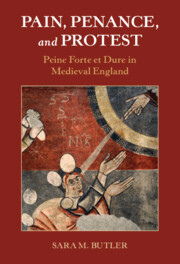Book contents
- Pain, Penance, and Protest
- Studies in Legal History
- Pain, Penance, and Protest
- Copyright page
- Contents
- Tables
- Acknowledgments
- Table of Statutes
- Abbreviations
- Introduction
- 1 Peine Forte et Dure: The Medieval Practice
- 2 Standing Mute in the Courts of Medieval England
- 3 Due Process and Consent to Jury Trial
- 4 Peine Forte et Dure as Barbarity? Putting the Practice in Context
- 5 Why Stand Mute?
- 6 Standing Mute as Imitatio Christi
- 7 Rejecting the Jury, Rejecting the Common Law, Rejecting the King
- Conclusion
- Bibliography
- Index
1 - Peine Forte et Dure: The Medieval Practice
Published online by Cambridge University Press: 19 November 2021
- Pain, Penance, and Protest
- Studies in Legal History
- Pain, Penance, and Protest
- Copyright page
- Contents
- Tables
- Acknowledgments
- Table of Statutes
- Abbreviations
- Introduction
- 1 Peine Forte et Dure: The Medieval Practice
- 2 Standing Mute in the Courts of Medieval England
- 3 Due Process and Consent to Jury Trial
- 4 Peine Forte et Dure as Barbarity? Putting the Practice in Context
- 5 Why Stand Mute?
- 6 Standing Mute as Imitatio Christi
- 7 Rejecting the Jury, Rejecting the Common Law, Rejecting the King
- Conclusion
- Bibliography
- Index
Summary
Chapter 1 examines precisely what peine forte et dure entailed during the Middle Ages. Paying special attention to the vocabulary related to peine forte et dure in the legal record, this chapter argues that “hard prison” (prison forte et dure) should be considered an umbrella term that includes a wide variety of practices, such as fasting, cold and nakedness, seclusion, and sometimes pressing. The make-up of the punishment depended on the nature of the crime and the defendant’s conduct at court. The traditional narrative sees an evolution in the practice from prison forte et dure, described as a starvation diet and miserable prison conditions, intended as a coercive measure to encourage the defendant to plead, gradually superseded by peine forte et dure, pressing with stones and irons unto death. The medieval evidence, instead, shows that some silent defendants fasted while others were pressed, and at no point did the practice shed its coercive nature altogether. This chapter also locates the practice’s origins in the church’s penitential practices, specifically in the public penance (paenitentia publica) assigned to murderers, political rebels, and other serious crimes.
- Type
- Chapter
- Information
- Pain, Penance, and ProtestPeine Forte et Dure in Medieval England, pp. 26 - 79Publisher: Cambridge University PressPrint publication year: 2021



